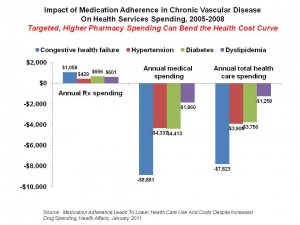 For every $1 spent on health care in the U.S., 10 cents goes to prescription drugs, 31 cents goes to hospital care, and 27 cents goes to professionals (doctors, dentists, and other services), based on 2009 health spending reported to the Centers for Medicare and Medicaid Services (CMS).
For every $1 spent on health care in the U.S., 10 cents goes to prescription drugs, 31 cents goes to hospital care, and 27 cents goes to professionals (doctors, dentists, and other services), based on 2009 health spending reported to the Centers for Medicare and Medicaid Services (CMS).
There’s evidence that by spending a bit more on medication and bolstering prescription drug adherence among patients, total health spending can be lowered for vascular medical conditions. The study and data which leads to this conclusion is published in Medication Adherence Leads to Lower Health Care Use And Costs Despite Increased Drug Spending appears in the January 2011 issue of Health Affairs.
The study cites the World Health Organization’s report from 2003 that stated medication compliance rates globally averaged about 50%. This number may be high compared with other newer studies on adherence, such as this comprehensive report from NEHI (formerly the New England Healthcare Institute).
Peoples’ lack of adherence to medication treatment regimes costs: diabetes patients who do not take their medications have a 58% increased risk for hospitalization and an 81% increased risk of mortality. The New England Healthcare Institute (NEHI) calculated that more than half of all Americans currently suffer from at least one chronic disease such as diabetes, heart disease and asthma at a cost to the economy of $1 trillion annually.
The Health Affairs study, sponsored by CVS (the retail pharmacy chain), established a causal link between medication adherence and outcomes: specifically, hospitalizations and total health costs. The researchers examined four conditions under the umbrella of vascular disease: congestive heart failure (CHF), hypertension, diabetes, and dyslipidemia (high cholesterol). Among these four conditions, bolstering adherence had positive impact (i.e., lowered) health costs across all categories, most markedly for CHF, as shown in the chart.
The average benefit-cost ratios from adherence for the four conditions were 8:4:1 for CHF, 10:1:1 for hypertension, 6:7:1 for diabetes, and 3:1:1 for dyslipidemia.
Health Populi’s Hot Points: Focusing just on CHF, the average cost-savings per patient was $7,893. About 5.7 million Americans have CHF, and there are 400,000 new cases of CHF in the U.S. each year, according to the National Heart, Lung and Blood Institute (NHLBI). Do the math: bolstering medication adherence among CHF patients could save $billions to the U.S., which would positively and directly impact Medicare — the nation’s largest threat to financial security in the not-so-long-term.
Furthermore, improving medication adherence as described in this study would avert hospital admissions for patients with vascular conditions, which would enhance millions of Americans’ quality of life and productivity. This is one example of how to bend the cost curve in health, and it doesn’t require a lot of new technology – just strong doses of sound communication between patients and doctors, access to prescription drugs and medication adherence programs, and a culture of participatory health where patients feel vested in their own care in partnering with their physicians.




 I'm in amazing company here with other #digitalhealth innovators, thinkers and doers. Thank you to Cristian Cortez Fernandez and Zallud for this recognition; I'm grateful.
I'm in amazing company here with other #digitalhealth innovators, thinkers and doers. Thank you to Cristian Cortez Fernandez and Zallud for this recognition; I'm grateful. Jane was named as a member of the AHIP 2024 Advisory Board, joining some valued colleagues to prepare for the challenges and opportunities facing health plans, systems, and other industry stakeholders.
Jane was named as a member of the AHIP 2024 Advisory Board, joining some valued colleagues to prepare for the challenges and opportunities facing health plans, systems, and other industry stakeholders.  Join Jane at AHIP's annual meeting in Las Vegas: I'll be speaking, moderating a panel, and providing thought leadership on health consumers and bolstering equity, empowerment, and self-care.
Join Jane at AHIP's annual meeting in Las Vegas: I'll be speaking, moderating a panel, and providing thought leadership on health consumers and bolstering equity, empowerment, and self-care.